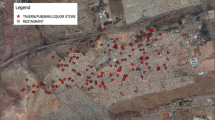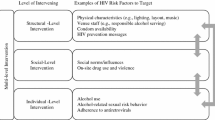Abstract
Addressing male heterosexual risk is a high priority for HIV prevention efforts in India. Particularly in urban India, which draws men for employment opportunities, these efforts are gaining momentum with a focus on understanding possible risk facilitators such as alcohol use. However, little is known about venues where such efforts might be targeted. In this paper, we explore community-based alcohol outlets or “wine shops” in Chennai, India, as potential venues. We conducted ethnographic research with wine shop staff and clients to understand alcohol use and sexual behaviors. We then surveyed 118 wine shop patrons to quantify these risk behaviors and plan an appropriate intervention. Our results show that wine shops are a venue where social and sexual networks converge. Reports and observations of regular and heavy drinking were frequent. Over 50% of patrons surveyed reported three or more sexual partners in the past 3 months, and 71% of all patrons reported a history of exchanging sex for money. Condom use history was low overall but, in the adjusted analyses, was significantly higher (OR = 20.1) among those who reported that their most recent partner was a sex worker and lower (OR = 0.28) among those who reported they drank to feel disinhibited. The data suggest that wine shops may be an appropriate location to target men for HIV prevention interventions. We discuss how these findings helped design such an intervention in Chennai.
Similar content being viewed by others
References
NACO. HIV/AIDS: Facts and Figures. Accessed on January 30, 2007. Available at: http://www.nacoonline.org.
Mundle M, Chatterjee S, Haldar A, Dobe M. A medico-social appraisal of commercial sex workers in a metropolitan city from eastern India. Southeast Asian J Trop Med Public Health. 2005;36(5):1325–1328.
Manjunath JV, Thappa DM, Jaisankar TJ. Sexually transmitted diseases and sexual lifestyles of long-distance truck drivers: a clinico-epidemiologic study in south India. Int J STD AIDS. 2002;13(9):612–617.
Cornman DH, Schmiege SJ, Bryan A, Joseph Benziger T, Fisher JD. An information-motivation-behavioral skills (IMB) model-based HIV prevention intervention for truck drivers in India. Soc Sci Med. 2007;64:1572–1584.
Basu IJ, Smarajit MD, Rotheram-Borus MJ, et al. HIV prevention among sex workers in India. J Acquir Immune Defic Syndr. 2004;36(3):845–852.
Sivaram S, Celentano DD. Training outreach workers for AIDS prevention in rural India: is it sustainable? Health Policy Plan. 2003;18(4):411–420.
Weir SS, Pailman C, Mahlalela X, Coetzee N, Meidany F, Boerma JT. From people to places: focusing AIDS prevention efforts where it matters most. AIDS. 2003;17(6): 895–903.
Weir SS, Morroni C, Coetzee N, Spencer J, Boerma JT. A pilot study of a rapid assessment method to identify places for AIDS prevention in Cape Town, South Africa. Sex Transm Infect. 2002;78(Suppl 1):i106–i113.
Tandon R. The making of a polio-free India. Indian J Pediatr. 2002;69(8):683–685.
Kincaid DL. Social networks, ideation, and contraceptive behavior in Bangladesh: a longitudinal analysis. Soc Sci Med. 2000;50(2):215–231.
Jana S, Basu I, Rotheram-Borus MJ, Newman PA. The Sonagachi Project: a sustainable community intervention program. AIDS Educ Prev. 2004;16:405–414.
Go VF, Sethulakshmi C, Bentley ME, et al. When HIV-prevention messages and gender norms clash: the impact of domestic violence on women’s HIV risk in slums of Chennai, India. AIDS Behav. 2003;7:263–272.
Sivaram S, Sethulakshmi C, Go V, et al. The use narrative scenarios to assess cultural norms of sexual behavior for an HIV prevention study in Chennai, India. In: Verma RK, Pelto PJ, Schensul SL, Joshi A, eds. Sexuality in the Time of AIDS: Contemporary Perspectives from Communities in India. New Delhi: Sage Publications; 2004.
Benegal V. India: alcohol and public health. Addiction. 2005;100(8):1051–1056.
Mohan D, Chopra A, Sethi H. A rapid assessment study on prevalence of substance abuse disorders in metropolis Delhi. Indian J Med Res. 2001;114:107–114.
Saunders JB, Aasland OG, Babor TF, de la Fuente JR, Grant M. Development of the alcohol use disorders screening test (AUDIT). WHO collaborative project on early detection of persons with harmful alcohol consumption. II. Addiction. 1993;88:791–804.
Chagas Silva M, Gaunekar G, Patel V, Kukalekar DS, Fernandes J. The prevalence and correlates of hazardous drinking in industrial workers: a study from Goa, India. Alcohol Alcohol. 2003;38(1):79–83.
Celentano DD, Srikrishnan AK, Sivaram S, Go VF, Latkin C, Solomon S. The HIV epidemic in Chennai (southern India) remains concetrated in high risk groups. Paper presented at the XV International AIDS Conference, 2004, Bangkok.
Madhivanan P, Hernandez A, Gogate A, et al. Alcohol use by men is a risk factor for the acquisition of sexually transmitted infections and human immunodeficiency virus from female sex workers in Mumbai, India. Sex Transm Dis. 2005;32(11):685–690.
Schensul SL, Mekki-Berrada A, Nastasi BK, Singh R, Burleson JA, Bojko M. Men’s extramarital sex, marital relationships and sexual risk in urban poor communities in India. J Urban Health. 2006;83(4):614–624.
Rogers E. Diffusion of Innovations. New York: The Free Press; 1995.
Kelly JA. Popular opinion leaders and HIV prevention peer education: resolving discrepant findings, and implications for the development of effective community programmes. AIDS Care. 2004;16(2):139–150.
Atlas TI [4.1] [computer program]. Version. Berlin: Scientific Software Development; 1997.
Liljeros F, Edling CR, Nunes Amaral LA. Sexual networks: implications for the transmission of sexually transmitted infections. Microbes Infect. 2003;5(2):189–196.
Puri CP, Balaiah D, Iyer KS. Increased male responsibility and participation: a key to improving the reproductive health. ICMR Bull. 1999;29(6):59–70.
Hendershot CS, George WH. Alcohol and sexuality research in the AIDS era: trends in publication activity, target populations and research design. AIDS Behav. 2007;11(2):217–226.
Stoner SA, George WH, Peters LM, Norris J. Liquid courage: alcohol fosters risky sexual decision-making in individuals with sexual fears. AIDS Behav. 2007;11(2):227–237.
Gordon CM, Carey MP, Carey KB. Effects of a drinking event on behavioral skills and condom attitudes in men: implications for HIV risk from a controlled experiment. Health Psychology. 1997;16(5):490–495.
Kumar R, Jha P, Arora P, et al. Trends in HIV-1 in young adults in south India from 2000 to 2004: a prevalence study. Lancet. 2006;367(9517):1164–1172.
Acknowledgements
The study was funded by the United States National Institute of Mental Health grant no. MHU10 681543-01. We would also like to acknowledge the support of Dr. Avni Amin who helped design and conduct the ethnography that is reported in this paper.
Author information
Authors and Affiliations
Corresponding author
Additional information
Sivaram, Go, and Celentano are with the Infectious Diseases Program, Department of Epidemiology, The Johns Hopkins Bloomberg School of Public Health, Baltimore, MD, USA; Johnson, Srikrishnan, and Solomon are with the YRG Center for AIDS Research and Education, Voluntary Health Services, Taramani, Chennai, 600113, India; Bentley is with the Global Health School of Public Health, University of North Carolina, Chapel Hill, NC, USA; Latkin is with the Department of Health, Behavior and Society, The Johns Hopkins Bloomberg School of Public Health, Baltimore, MD, USA.
Rights and permissions
About this article
Cite this article
Sivaram, S., Johnson, S., Bentley, M.E. et al. Exploring “Wine Shops” as a Venue for HIV Prevention Interventions in Urban India. J Urban Health 84, 563–576 (2007). https://doi.org/10.1007/s11524-007-9196-0
Received:
Accepted:
Published:
Issue Date:
DOI: https://doi.org/10.1007/s11524-007-9196-0




